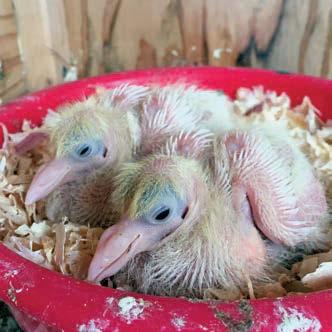
7 minute read
Hobbies: Coming home
Coming HOME
A P.E.I. writer shares the joys and fears of raising pigeons
WORDS AND PHOTOS BY DAVE ATKINSON
Istood at my back door in Charlottetown, scanning the horizon. It was about an hour before sunset.
“Any sign of them yet?” asked my daughter Alice. She’s 11. “Not yet,” I said. “They’ll be back soon. Just watch.”
“You’re sure?” she said. Her forehead was scrunched. She was worried. “Of course I’m sure.” I put my arm around her. “They’re homing pigeons. They come home. It’s what they do.”
XI’ve been interested in pigeons for years, but it wasn’t until last year I finally built a loft. We brought in our first birds from a fellow in Bonshaw, P.E.I. The kids named them Hermes and Violet.
They’re racing homers specially bred for their ability to come home from a distance, even if they’ve never seen their starting point. In some races, birds travel up to 2,000 km.
“That’s the miracle of pigeons,” said Barry McPhee, a longtime pigeon fancier in Sussex, N.B. Barry has kept pigeons since 1967, after he met some on a school field trip to a local farm. By summer, he built his own loft. He’s been flying them ever since.



Top: Georgie and Poppy on Atkinson’s head. Middle: Atkinson’s daughter Alice has a way with pigeons. Bottom: Baby pigeons.
“I’ve always loved a bird in flight,” he says. “You open the door, and they’re free to fly wherever they want. They don’t have to come back, but they always do.”
When he started, McPhee says there were hundreds of fanciers across Atlantic Canada. The numbers have dropped over the years. He figures there are maybe 50–60 people who keep pigeons left and few of those actually fly their birds. Most keep them just for show. “Most of the fellows I’ve shown or flown with over the years have retired or are gone,” he says. “Even the younger fanciers are in their 50s now. There aren’t a lot of young people picking up the stick.”
XViolet and Hermes are lovely birds but we can’t let them fly free. Their homing instinct is so strong, they would head straight to the loft in Bonshaw where they were born. Their kids, however, are a different story.
“HATCHING!!!” read the text from my wife, the day our first egg pair began to crack. I sped home from work, just in time to see two alien dinosaur birds emerge from their shells.
We named them Poppy and Georgie and gushed over them for the next few weeks as white feathers replaced their sparse yellow down. Pigeon parents create a special “milk” in their crop (part of the digestive system) that they feed their babies. At four weeks, we weaned Poppy and Georgie and moved them to their own flight loft.
That’s when training began. Before this, they ate freely from their food trough at all hours. I started feeding them smaller meals, twice daily, of grains, corn, seeds, and legumes. I made a big production of rattling the food in its can and whistling as I dished up supper.
Before they could fly, I taught them to enter their loft through a special pigeonsonly door called the trap. I placed them on a landing board just outside the trap and started whistling and rattling their food.
BE A GOOD NEIGHBOUR

If your birds spend time on your neighbour’s roof, you’re doing something wrong. Fly your birds hungry so they’re keen to come home for dinner. Keep your loft clean and be mindful of the noise.
I squeezed their little shoulders through the trap, and they dropped into the loft, where their food waited.
I only had to show them once. Poppy and Georgie soon discovered their wings were made for flying. I’ll always remember their first trip to the peak of the shed. They were flying from the picnic table to the roof of their loft and missed their landing. A few panic-flaps later, and they found themselves on the shed, looking down, wondering how they got there. They stayed there for more than an hour. I whistled for their supper, and they came right away. They hit the landing board on the first try and popped through the trap.
X“It’s the best feeling in the world,” says Dave Blum. He invited me to see his loft in Belfast, P.E.I. Dave grew up with pigeons, but faded on the hobby as an adult and went 25 years without keeping pigeons. He toyed with the idea for a while and got back into it last year in a big way.
“I’m the kind of guy who always needs a challenge, other than work,” he says.
There are hundreds of pigeon breeds, but Blum wanted to raise homers and race them in a club. He spent several years researching breeders before finally selecting one in Pennsylvania. The winter before his birds arrived, he got to work on his loft.
BUILD YOUR OWN LOFT
Check your local bylaws first. Charlottetown’s nuisance bylaw prohibits livestock, but doesn’t count pigeons in its list of banned animals (I contacted them first to be sure).
I built my small loft for a few hundred dollars. It holds fewer than 12 birds. Blum’s loft is larger and more elaborate. It cost about $3,000. “It was the biggest cost in getting back into the hobby,” he says.
Unlike chickens, pigeons don’t need heat in the winter. The loft should be dry and free of drafts. Make sure to give them space to spend outside every day, like an enclosed aviary.
There are loads of resources online and in Facebook forums. It’s easy to find other bird people, once you become one yourself. Attend a bird show and chat someone up.
“I probably read every magazine and watched every YouTube video there is before I settled on my loft design.” He chuckles, “And I got to tell you, there are a lot of videos and magazines on the subject.”
Blum joined the Central Nova Racing Pigeon Club, which despite McPhee’s observation of a shrinking hobby, has grown in the last few years. Blum trained his young birds in the spring for a summer of races.
He started by letting them out every day about an hour before supper. They’d explore the immediate area around his farm and come home. After a few weeks, he carefully placed them in a special basket and released them about eight kilometres from his loft. They beat him home. Every day, Blum went a little further, expanding their range. One day, he realized to get much farther, he’d have to take them across the Confederation Bridge connecting P.E.I. and Nova Scotia.
“I released them right at the base of the bridge,” hey says. “They circled the base, getting their bearings. I thought they’d either not want to cross, or they’d follow the bridge itself, but they took off across the Strait. Draw a line on a map, and it would have pointed right at my farm in Belfast. It was a great feeling.” X “They’re back!” shouted Alice. “Poppy and Georgie! They’re on the shed!”
“I told you they’d be back,” I said as we pulled on our boots and slipped out the back door. I headed to the shed and grabbed a scoop of food. By the time I emerged, the birds were already on Alice’s shoulders, nipping at her ears. She’s the pigeon whisperer. They adore her. The other kids love the birds, but Alice has been a constant presence for Poppy and Georgie since they were eggs.
I let them play a minute before I shook the can and whistled for supper. They flew to the landing board and popped through the trap.
I only had to show them how to do that once. X It’s an act of faith every time I open the loft to let them out. It’s a great big world with predators and bad weather and any number of things that could stop them from coming home. Like McPhee said, they don’t have to come home, but they always do.
I locked up the loft. They were safe for the night. Blum is right; when your birds come home, it’s the best feeling in the world. o

FURNISHINGS
DESIGN HAS A NEW HOME
Modern furniture and accessories and custom one-of-a-kind works by local and international artists and designers
3065 Robie Street Halifax Nova Scotia B3K 4P6
902 423 2557 info@attica.ca






